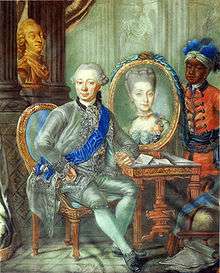Seyler & Tillemann
|
A silhouette of Abel Seyler | |
| Industry | Financial services |
|---|---|
| Founder | Abel Seyler and Johann Martin Tillemann |
| Headquarters | Hamburg |
Seyler & Tillemann was a Hamburg bank in the mid 18th century, that went bankrupt in 1763. It was owned by the merchants Abel Seyler and Johann Martin Tillemann, and notably involved itself in the currency market and speculation with financial instruments. It also owned a large silver refinery in Hamburg.

During the Seven Years' War, Seyler & Tillemann speculated heavily on currency debasement. The bank leased the mint factory in Rethwisch in cooperation with their business partner Heinrich Carl von Schimmelmann and produced large amounts of coins (so-called Heckmünzen), that were exported to various German states during the war. Mainly as a result of the large-scale currency speculation, the company went bankrupt in what was termed a "malicious bankruptcy" with 3 million Mark Banco in debts, but Seyler and Tillemann were able to retain some of their fortunes. Despite suffering "a sensational bankruptcy for an enormous sum [...] neither of them had lost his good humour or his taste for light living."[1] The bankruptcy resulted in extensive litigation, that reached the Imperial Cameral Tribunal in 1765; the court documents offer "an excellent perspective on 'deceitful schemes' and especially on the bill-jobbing" of the related companies Seyler & Tillemann and Müller & Seyler.[2]
Abel Seyler later became famous as a theatre director, and was the father of the noted banker L.E. Seyler, the senior partner of Berenberg Bank for nearly half a century.
Literature
- Mary Lindemann, "The Anxious Merchant, the Bold Speculator, and the Malicious Bankrupt: Doing Business in Eighteenth-Century Hamburg," in Margaret C. Jacob and Catherine Secretan (eds.), The Self-Perception of Early Modern Capitalists, Palgrave Macmillan, 2009

